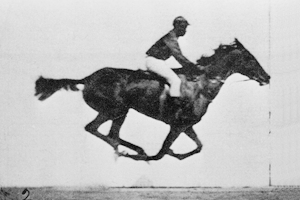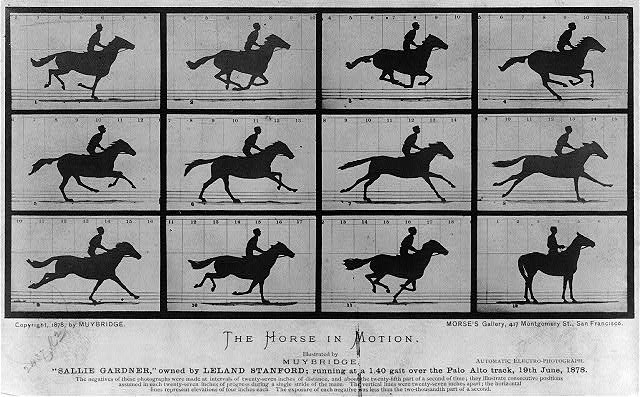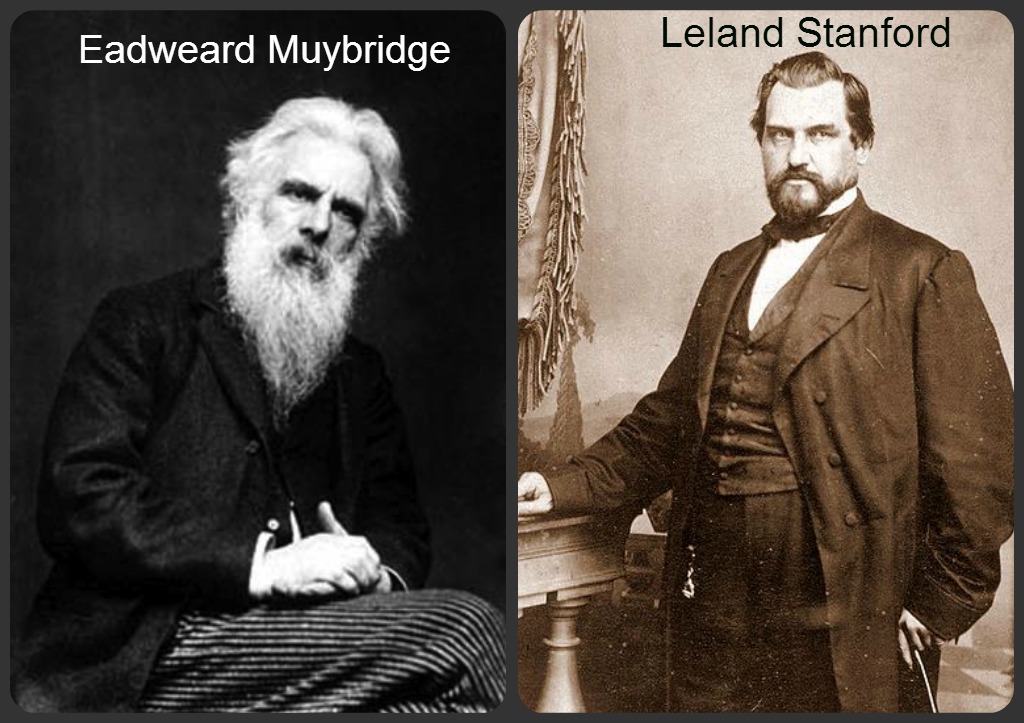“Sallie Gardner at a Gallop”

Muybridge sequence of a horse galloping (Source).
In 1872, Leland Stanford, an industrialist and horseman, commissioned English photographer Eadweard Muybridge to help determine whether a horse ever lifts all four feet completely off the ground at any given time during a trot or gallop. While trying to figure out Stanford’s question Muybridge invented a motion picture projector and new photographic techniques.
After over five years of experiments and engineering, Stanford finally got his answer when Muybridge was able to build a camera that was up to the job. Not just one camera, but a dozen of them!
Muybridge lined all 12 cameras alongside the track. As the horse passed the cameras, it would trigger strings that would activate the shutters one at a time and in sequence. Among the resulting images was Stanford’s answer: Yes, all four hooves leave the ground, briefly, during a trot.
Not completely satisfied, Stanford wanted to try it again but with a galloping horse to see if it the result was the same. In June 1878, Muybridge repeated the exercise with a galloping horse. However, this time he doubled the amount of cameras from 12 to 24 and placed them 27 inches apart.
The horse, Sallie Gardner, kicked the camera strings as she galloped by. In order to reflect as much light as possible, the track was lined with cloth sheets.

The Horse in Motion by Eadweard Muybridge. “Sallie Gardner,” owned by Leland Stanford; running at a 1:40 gait over the Palo Alto track, June 19, 1878. Photo Credit: Library of Congress
In order to display the images, Muybridge created what is considered to be the first movie projector – a Zoopraxiscope. He would copy the images in the form of silhouettes onto glass disks. When rotated, the images appeared as if in motion and one rotation lasted about 3 seconds.
While Sallie Gardner at a Gallop was an experiment, it was also one of the earliest silent films. Muybridge achieved many impressive photographic feats during his lifetime and was considered a pioneer in photographic studies of motion and motion picture projection.
[Zim’s Note: Since I could not find any place within this post to organically include the following two “trivia” facts about Muybridge and Stanford, I decided to just include it here as a footnote.
- Muybridge literally got away with murder in 1874. He was prosecuted and acquitted in the murder of his young wife’s lover, Harry Larkyns, a San Francisco Post drama critic. The jury found that the killing was a justifiable homicide under “unwritten law.”
- In 1885, Leland Stanford founded Stanford University along with his wife Jane as a memorial for their only child Leland Stanford, Jr., who died of typhoid fever at the age of fifteen. Stanford University’s official name is actually “Leland Stanford Junior University.”]
Sources
Leslie, Mitchell, “The Man Who Stopped Time,” Stanford Alumni Magazine, May/June 2001.
Joe Rayment, “Eadweard J. Muybridge – one of the original men in motion – celebrated with a Google Doodle,” National Post, April 9, 2012.
Joe Stanford, “Cantor exhibit showcases motion-study photography,” Stanford Report, February 12, 2003.
“Sallie Gardner at a Gallop,” San Francisco Museum.
“The Birth of the University,” Stanford University.











